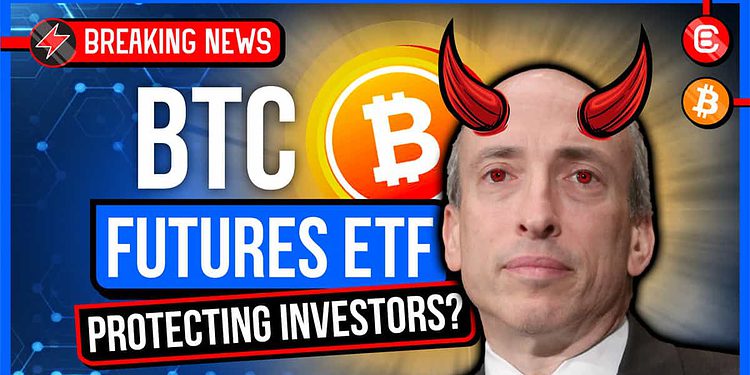TL;DR
- What do futures ETFs really mean for investors?
- Why does the SEC favor them?
- What’s the agenda?
- When will we see a spot ETF in the US?
As the saying goes, be careful what you wish for.
The recent approval of four Bitcoin ETFs was heralded by many as a coming-of-age for the young asset class – crypto’s long-awaited Bar Mitzvah moment. However, the reality is that these futures ETFs are doing precisely what early detractors promised they would: serving neither the crypto space, nor the investors the Securities Exchange Commission (SEC) is supposed to protect.
Data doesn’t lie. Just check out this chart mapping the Bitcoin price with the ProShares Bitcoin Strategy ETF:
https://twitter.com/charliebilello/status/1467527613543600145/photo/1
You don’t need to be a master chartist to see that $BITO has massively underperformed BTC itself. Clearly, buying actual BTC would have yielded better returns. In fact, the performance disparity is so significant that the SEC’s position (‘Bitcoin is too volatile’) simply doesn’t add up.
Which begs the question: who is the SEC actually protecting? After all, it clearly isn’t you or me. To answer the question, we first need to consider what a futures ETF actually is.
Futures can seem like a lot to wrap our heads around. In simple terms, they represent a contract to buy or sell a predetermined amount of something at a future date. Investors are effectively purchasing the agreement to buy (or sell) at a specific price, at a specific time. An Exchange Traded Fund (ETF) is a vehicle that simply reflects the price of an asset, commodity, or, as with things like the S&P 500, a basket of many.
A Bitcoin ETF means that – rather than having to buy and store Bitcoin itself – investors can gain exposure to the asset through a vehicle they already understand.
In the case of a spot ETF, the asset is backed by cold-stored Bitcoin. With a futures ETF, it’s backed by contracts. And guess what? As the above chart demonstrates, futures ETFs almost always tend to underperform the underlying asset.
Why?
Well, rather than buying the asset or commodity directly, futures provide indirect exposure as contracts covering a fixed period. To maintain exposure, investors need to sell their contracts for ones with a later date of expiration. In simple terms: if they think numbers will go up, those later contracts are more expensive. When investors sell cheaper contracts only to re-buy at a higher price, they effectively lose money.
Sub-optimal futures contracts make sense in some cases – agricultural commodities, for example. After all, nobody wants to hold crude oil, livestock, or (worst of all) pork cutouts.
But for an asset that investors can actually own, which comes without storage costs or convenience yield, a BTC futures ETF makes little (if any) sense. Not only does it underperform the underlying asset, but the combination of punitive fees and contango (when prices for the further-dated futures contracts exceed the short-dated ones) make it a pretty dismal deal for the average investor.
SEC chairman Gary Gensler may be many things, but a fool isn’t one of them; he knows as well as anyone that a futures-based ETF would yield sub-optimal returns.
So why did he approve it? In what universe do inferior returns amount to investor protection?
The easy answer is that futures ETFs are regulated, making this the lazy choice for the SEC. They’re on the Chicago Mercantile Exchange (CME) and fall under the jurisdiction of the Commodities Futures Trading Commission (CFTC). Great. But it only tells half the story. And that’s because the real beneficiaries of a futures-based ETF are the very middlemen Bitcoin was designed to circumvent – namely, Wall Street.
A spot ETF is one thing, but the relative complexity of a Bitcoin futures ETF provides an opportunity for a whole host of players to get some skin in the game: the arbitrageurs, auditors, lawyers, and legal firms all are able to line their pockets in the process, securing a slice of the pie. At this point, it remains the most compelling reason why the SEC is resisting a spot ETF. By giving contango-fuelled losses the thumbs-up, their argument that Bitcoin is too volatile is thin, very thin, indeed.
Nonetheless, the prevailing consensus is that a ‘physically-backed’ Bitcoin ETF is inevitable. After all, they’ve already been approved in Canada and several European nations – and what does the US hate more than losing to those guys?
When the SEC will approve the first remains to be seen. Only a few weeks ago, VanEck’s application for a spot ETF was rejected by the powers that be.
The wait continues.
All this proves what early skeptics were saying from the start: rather than paving the way for an imminent spot ETF (which would introduce a massive inflow of institutional investment on-chain), a futures ETF isn’t better than nothing, it’s actually something worse – an underperforming asset that does investors a disservice, serves the institutions, and undermines the very precept of self custody at the heart of the crypto space.
Banter wisdom
By approving a futures ETF, the SEC has shown its hand: claiming to protect us while doing the very opposite.
Also, just as it could be a while before a spot ETF opens the floodgates, success in crypto often means playing the waiting game. After the recent dump, trying to make up any losses with high-leverage longs/shorts will almost certainly spell disaster.
Spot and chill.
As Sheldon so often reminds us, this is a business where patience pays off.







